Week 29--March 8-14, 2020
This has been a very eventful week. Tom and Garnalee both celebrated birthdays, Tom on Sunday and Garnalee on Friday. However the big news for the week has been the CO-VID19 (coronavirus) that has arrived in the United States. The NCAA March Madness Tournament was cancelled, also the NBA basketball season, the MLB is delaying their season, and Disneyland closed. The Church of Jesus Christ of Latter-day Saints made major adjustments and changes were being announced on a daily basis. It was announced that General Conference would only be done virtually; all large gatherings were cancelled; all senior missionaries and young missionaries with health problems were sent home which affected 22 missions; all worship services were cancelled; all classes at BYU and BYU-I were cancelled and will be completed remotely; the Tabernacle Choir cancelled all concerts and closed their rehearsals and broadcasts; all proxy temple work was suspended; Temple Square and surrounding buildings were closed; all historic sites visitors' centers were closed; and a total of 26 temples around the world have been closed. We tried to go visit some museums on our P-Day on Saturday and they were closed.
We had a P-Day on Monday so we went to the Miniature and Toy Museum in Kansas City. Most of the items in the museum were a 1:12 ratio. This is the first thing a visitor to the museum sees. In this picture it shows the chair, table, a framed cross stitch on the wall, and a candlestick that was perfectly duplicated in miniature in the glass case to the side.
A harpsichord that had strings that could be tuned and working keys. It is only about 5" long.
Here we see a tiny teapot that had a removable lid so it could be used. It wouldn't be able to hold more than a single drop of water, and most likely wouldn't be able to pour out the very tiny spout because of the surface tension of the water. With no reference point, it's hard to realize that this teapot isn't any larger than a single kidney bean.
A table with inlaid wood.
These are pieced quilts. The pieces of fabric are the size of the fingernail on you little finger.
This house was 1:48 scale. The master craftsman spent 5 years constructing the house, including its furniture and garden. He also created the oil paintings displayed throughout the house. He enjoyed the challenge of working in small scale, describing it as "trying to hold a gnat while clipping its wings."
The chess set was craved just like a bigger one.
To create this rug the craftsman graphed the design and calculated the number of knots required. This carpet measures 4 7/8 inches by 3 1/4 inches but contains 17,641 knots.
The "exploded" spice cabinet shows the intense level of craftsmanship that goes into making the miniature items. The drawers and case are dovetailed and the door frame is held together with mortise and tenon joints. The cabinet is made of cherry, Swiss pear, poplar, and briar wood, and even contains a secret compartment. A steel key fits the functioning brass and steel lock which is hard to see in this picture. Interestingly, miniatures use the very same pieces that would be used to build a full sized piece of furniture.
This sweater with a Christmas motif was knitted with fine wire for the knitting needles. Note the pictures on the front and back.
This picture shows the number of pieces required to build the door. As with the cupboard seen earlier, construction of this door is the same as what would be needed for a full scale door.
This piece allows you to get a feel for scale. Inside the violin is a violin maker's shop. You can see the six tiny violins hanging to dry along with the cello leaning against the work bench. Truly amazing.
There were many doll houses here. This doll house was not a single-family home. Rising six stories, the dolls' apartment building features faux masonry blocks, roof and balcony banisters, and mixture of arched and rectangular windows--89 in all! The structure was wired for electricity, so lights can be turned on in any room with the functioning light switch.
After the miniature part of the museum we went upstairs to the toy section. I remember playing with these.
A nice collection of matchbox cars.
The days of playing shooting marbles on the playground at school.
Pic-up sticks, Tiddley Winks, a Gyroscope, and Jacks.
Our dolls had a whole wardrobe of clothes. Note the slip, nylons with seams, and even a small bra.
Every boy loved to play with GI Joe.
A Mouse Trap Game like one that Garnalee had when she was young.
Etch a Sketch, a Barrel of Monkeys, and the Magic 8 Ball. Is it really magic? Using a floating 20-sided die inside a plastic ball filled with a blue liquid, the Magic 8 Ball has answered (or postponed answering) thousands of questions since the 1940s.
The Fisher Price Garage. Garnalee remembers Scott playing with one these when he was little. It was one of his favorite toys.
Every little girl loved her Betsy Wetsy Doll and Mr and Mrs Potato Head.
In order to keep safe we are all encouraged not to shake hands but to elbow bumps. The sisters are practicing.
Pictured: Front:Sister Romero, Kait Moritz (who is back for a visit), Sister Pomeroy, Sister Henderson, Sister Morgenegg.
Middle: Sister Mills, Sister Alldredge, Sister Flindt, Sister Smith.
Back: Sister Pulley, Sister Leakehe.
We visited the grave of Jim Bridger. The engraving says, "Celebrated as a hunter, trapper, fur trader and guide, discovered Great Salt Lake 1824, the South Pass 1827, visited Yellowstone Lake and geysers 1830, founded Ft. Bridger 1843, opened overland route by Bridger's Pass to Salt Lake, was guide for U. S. exploring expeditions, Albert Sidney Johnston's Army in 1857, and G. M. Dodgein U. P. surveys and Indian campaigns 1856-66. This monument is erected as a tribute to his pioneer work by Maj. Gen. G. M. Dodge."
The time has arrived to say good-bye to Sister Morgenegg. She completes her mission next week.
Pictured Front: Sister Alldredge, Sister Pomeroy, Sister Morgenegg, Sister Henderson, and Sister Romero.
Back: Sister Smith, Sister Leakehe, Sister Flindt, Sister Pulley, and Sister Mills.
Tom in the Brady Courtroom at the Truman Courthouse. This is the oldest part of the courthouse and has been in use since 1838.
The last remaining clock from the 1933 system was disconnected at 7:50 AM on December 26, 1972 to mark the passing of Harry S. Truman.
Garnalee in the Truman's Chambers where he would hear land issues as County Commissioner of Jackson County.
Tom in Truman's office. Truman could see the unemployed men walking on the sidewalk outside of his window during the Depression. When he had a letter to be delivered, instead of using the courier service, he would give his secretary a quarter to go and get one of the men to deliver the letter. The man would be given the letter and the address. When he returned to collect his pay, the secretary would call to make sure the letter had been delivered, and then he would be given his money. He could go across the street and get a cup of coffee and a sandwich for 15 cents and have money left over. Truman was very concerned about the unemployed in the Depression. He developed a project for paved roads throughout Jackson County to give the men jobs using funds from the Works Progress Administration.
One area of the Truman Courthouse housed the art work of George Caleb Bingham. This picture is titled Order No. 11. When William Quantrill and his guerrillas raided Lawrence, Dansas, they left 200 dead. In response the Federal Government. Commander of the District Border, Brigadier-General Thomas Ewing, Jr. issued Order No. 11. It required all civilians in four Missouri border counties, including Jackson County, regardless of their loyalty to report to military stations.
The story is told that when Kate Doneghy awoke to the sound of Federal soldiers approching her home she was, no doubt, terrified. In this time of Civil War, where countrymen squared off against fellow countrymen, residents of the area faced acts of terrorism and strictly enforced martial law on a daily basis. As the soldiers approached the home they had but one thing in mind: Burn it to the ground. The family was ordered out of the house and the torches were lit, then Kate's youngest son cried out to save the family Bible. Whatever the reason, the Federal soldiers took mercy on the Doneghy family, spared their house, and headed off into the night.
The purpose of Order No. 11 was total depopulation and banishment of everyone from the four counties. There about 40,000 people living within the four affected counties. Within 15 days, the population of Cass County decreased from 7,000 to around 800. Bates and northern Vernon counties became ghost counties. The total population of Jackson County evicted under Order No. 11 is estimated at about 14,000 citizens.
It is said that the state of Missouri and Jackson County suffered greatly during the Civil War because of the treatment of the "Mormons" 30 years earlier.
 Tom next to the statue of Harry S. Truman on the west end of the courthouse.
Tom next to the statue of Harry S. Truman on the west end of the courthouse.
The Truman Courthouse from the north side. The original courthouse that was built in 1838 is contained within the additions added later.
We ended our week at Moon Marble Company where we able to see the making of a marble.
The glass is taken from a kiln where it is heated some. Then it is heated so the glass is pliable and be shaped into a marble.
This man visited the shop when he was 15 and saw how the custom marbles were made. He went home and started to develop his talent.
The glass was flatted so that a metal could be placed on the glass that would make it shiny. Then glow in the dark powder was added.
The marble taking shape and a black light is used to show the glow.
Shaping the glass into a round ball and adding a background color.
A few of the custom made marbles that were made last week during a marble makers convention. The whole store was fascinating.
This has been a very eventful week. Tom and Garnalee both celebrated birthdays, Tom on Sunday and Garnalee on Friday. However the big news for the week has been the CO-VID19 (coronavirus) that has arrived in the United States. The NCAA March Madness Tournament was cancelled, also the NBA basketball season, the MLB is delaying their season, and Disneyland closed. The Church of Jesus Christ of Latter-day Saints made major adjustments and changes were being announced on a daily basis. It was announced that General Conference would only be done virtually; all large gatherings were cancelled; all senior missionaries and young missionaries with health problems were sent home which affected 22 missions; all worship services were cancelled; all classes at BYU and BYU-I were cancelled and will be completed remotely; the Tabernacle Choir cancelled all concerts and closed their rehearsals and broadcasts; all proxy temple work was suspended; Temple Square and surrounding buildings were closed; all historic sites visitors' centers were closed; and a total of 26 temples around the world have been closed. We tried to go visit some museums on our P-Day on Saturday and they were closed.
We had a P-Day on Monday so we went to the Miniature and Toy Museum in Kansas City. Most of the items in the museum were a 1:12 ratio. This is the first thing a visitor to the museum sees. In this picture it shows the chair, table, a framed cross stitch on the wall, and a candlestick that was perfectly duplicated in miniature in the glass case to the side.
A harpsichord that had strings that could be tuned and working keys. It is only about 5" long.
Here we see a tiny teapot that had a removable lid so it could be used. It wouldn't be able to hold more than a single drop of water, and most likely wouldn't be able to pour out the very tiny spout because of the surface tension of the water. With no reference point, it's hard to realize that this teapot isn't any larger than a single kidney bean.
A table with inlaid wood.
These are pieced quilts. The pieces of fabric are the size of the fingernail on you little finger.
This house was 1:48 scale. The master craftsman spent 5 years constructing the house, including its furniture and garden. He also created the oil paintings displayed throughout the house. He enjoyed the challenge of working in small scale, describing it as "trying to hold a gnat while clipping its wings."
The chess set was craved just like a bigger one.
To create this rug the craftsman graphed the design and calculated the number of knots required. This carpet measures 4 7/8 inches by 3 1/4 inches but contains 17,641 knots.
The "exploded" spice cabinet shows the intense level of craftsmanship that goes into making the miniature items. The drawers and case are dovetailed and the door frame is held together with mortise and tenon joints. The cabinet is made of cherry, Swiss pear, poplar, and briar wood, and even contains a secret compartment. A steel key fits the functioning brass and steel lock which is hard to see in this picture. Interestingly, miniatures use the very same pieces that would be used to build a full sized piece of furniture.
This sweater with a Christmas motif was knitted with fine wire for the knitting needles. Note the pictures on the front and back.
This picture shows the number of pieces required to build the door. As with the cupboard seen earlier, construction of this door is the same as what would be needed for a full scale door.
This piece allows you to get a feel for scale. Inside the violin is a violin maker's shop. You can see the six tiny violins hanging to dry along with the cello leaning against the work bench. Truly amazing.
There were many doll houses here. This doll house was not a single-family home. Rising six stories, the dolls' apartment building features faux masonry blocks, roof and balcony banisters, and mixture of arched and rectangular windows--89 in all! The structure was wired for electricity, so lights can be turned on in any room with the functioning light switch.
After the miniature part of the museum we went upstairs to the toy section. I remember playing with these.
A nice collection of matchbox cars.
The days of playing shooting marbles on the playground at school.
Pic-up sticks, Tiddley Winks, a Gyroscope, and Jacks.
Our dolls had a whole wardrobe of clothes. Note the slip, nylons with seams, and even a small bra.
Every boy loved to play with GI Joe.
A Mouse Trap Game like one that Garnalee had when she was young.
Etch a Sketch, a Barrel of Monkeys, and the Magic 8 Ball. Is it really magic? Using a floating 20-sided die inside a plastic ball filled with a blue liquid, the Magic 8 Ball has answered (or postponed answering) thousands of questions since the 1940s.
The Fisher Price Garage. Garnalee remembers Scott playing with one these when he was little. It was one of his favorite toys.
Every little girl loved her Betsy Wetsy Doll and Mr and Mrs Potato Head.
In order to keep safe we are all encouraged not to shake hands but to elbow bumps. The sisters are practicing.
Pictured: Front:Sister Romero, Kait Moritz (who is back for a visit), Sister Pomeroy, Sister Henderson, Sister Morgenegg.
Middle: Sister Mills, Sister Alldredge, Sister Flindt, Sister Smith.
Back: Sister Pulley, Sister Leakehe.
We visited the grave of Jim Bridger. The engraving says, "Celebrated as a hunter, trapper, fur trader and guide, discovered Great Salt Lake 1824, the South Pass 1827, visited Yellowstone Lake and geysers 1830, founded Ft. Bridger 1843, opened overland route by Bridger's Pass to Salt Lake, was guide for U. S. exploring expeditions, Albert Sidney Johnston's Army in 1857, and G. M. Dodgein U. P. surveys and Indian campaigns 1856-66. This monument is erected as a tribute to his pioneer work by Maj. Gen. G. M. Dodge."
The time has arrived to say good-bye to Sister Morgenegg. She completes her mission next week.
Pictured Front: Sister Alldredge, Sister Pomeroy, Sister Morgenegg, Sister Henderson, and Sister Romero.
Back: Sister Smith, Sister Leakehe, Sister Flindt, Sister Pulley, and Sister Mills.
Tom in the Brady Courtroom at the Truman Courthouse. This is the oldest part of the courthouse and has been in use since 1838.
The last remaining clock from the 1933 system was disconnected at 7:50 AM on December 26, 1972 to mark the passing of Harry S. Truman.
Garnalee in the Truman's Chambers where he would hear land issues as County Commissioner of Jackson County.
Tom in Truman's office. Truman could see the unemployed men walking on the sidewalk outside of his window during the Depression. When he had a letter to be delivered, instead of using the courier service, he would give his secretary a quarter to go and get one of the men to deliver the letter. The man would be given the letter and the address. When he returned to collect his pay, the secretary would call to make sure the letter had been delivered, and then he would be given his money. He could go across the street and get a cup of coffee and a sandwich for 15 cents and have money left over. Truman was very concerned about the unemployed in the Depression. He developed a project for paved roads throughout Jackson County to give the men jobs using funds from the Works Progress Administration.
One area of the Truman Courthouse housed the art work of George Caleb Bingham. This picture is titled Order No. 11. When William Quantrill and his guerrillas raided Lawrence, Dansas, they left 200 dead. In response the Federal Government. Commander of the District Border, Brigadier-General Thomas Ewing, Jr. issued Order No. 11. It required all civilians in four Missouri border counties, including Jackson County, regardless of their loyalty to report to military stations.
The story is told that when Kate Doneghy awoke to the sound of Federal soldiers approching her home she was, no doubt, terrified. In this time of Civil War, where countrymen squared off against fellow countrymen, residents of the area faced acts of terrorism and strictly enforced martial law on a daily basis. As the soldiers approached the home they had but one thing in mind: Burn it to the ground. The family was ordered out of the house and the torches were lit, then Kate's youngest son cried out to save the family Bible. Whatever the reason, the Federal soldiers took mercy on the Doneghy family, spared their house, and headed off into the night.
The purpose of Order No. 11 was total depopulation and banishment of everyone from the four counties. There about 40,000 people living within the four affected counties. Within 15 days, the population of Cass County decreased from 7,000 to around 800. Bates and northern Vernon counties became ghost counties. The total population of Jackson County evicted under Order No. 11 is estimated at about 14,000 citizens.
It is said that the state of Missouri and Jackson County suffered greatly during the Civil War because of the treatment of the "Mormons" 30 years earlier.
 Tom next to the statue of Harry S. Truman on the west end of the courthouse.
Tom next to the statue of Harry S. Truman on the west end of the courthouse.The Truman Courthouse from the north side. The original courthouse that was built in 1838 is contained within the additions added later.
We ended our week at Moon Marble Company where we able to see the making of a marble.
The glass is taken from a kiln where it is heated some. Then it is heated so the glass is pliable and be shaped into a marble.
This man visited the shop when he was 15 and saw how the custom marbles were made. He went home and started to develop his talent.
The glass was flatted so that a metal could be placed on the glass that would make it shiny. Then glow in the dark powder was added.
The marble taking shape and a black light is used to show the glow.
Shaping the glass into a round ball and adding a background color.
A few of the custom made marbles that were made last week during a marble makers convention. The whole store was fascinating.





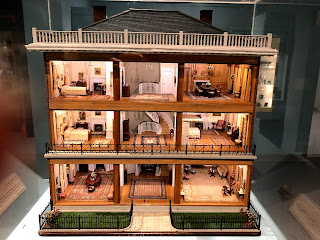




















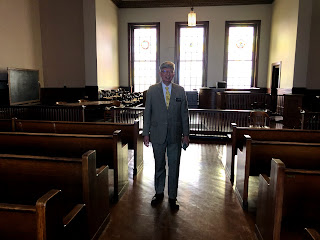

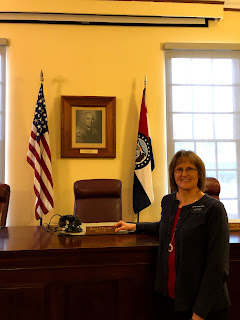
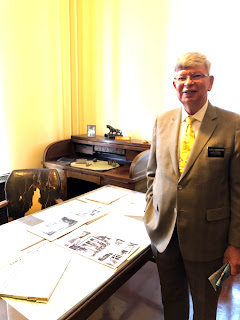

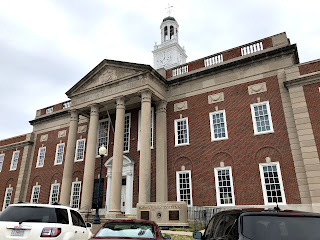


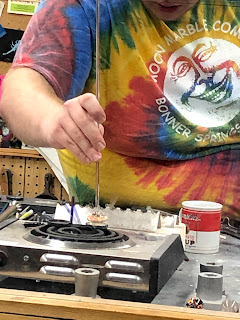



No comments:
Post a Comment